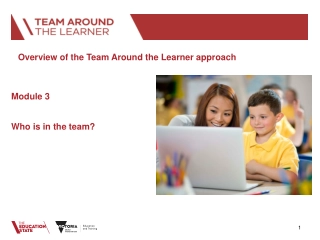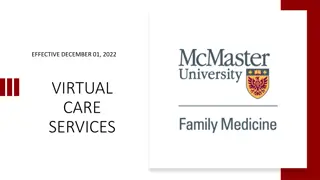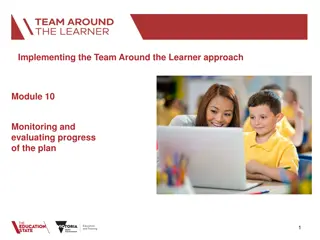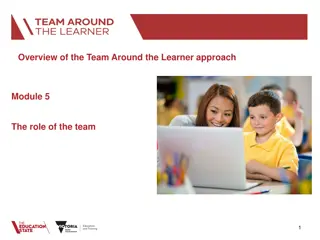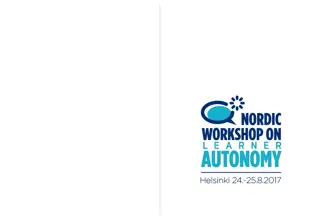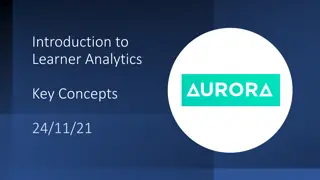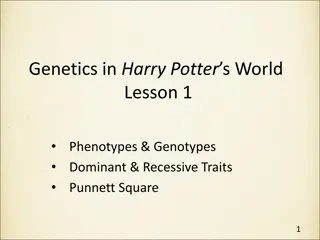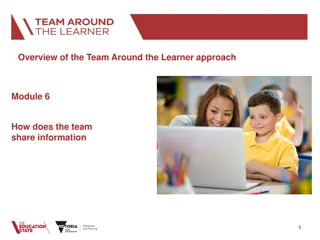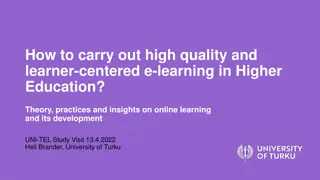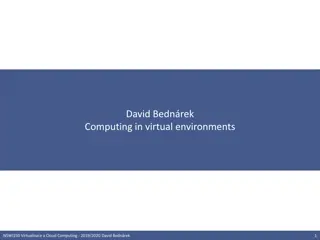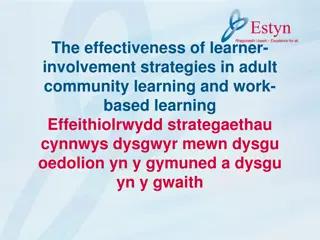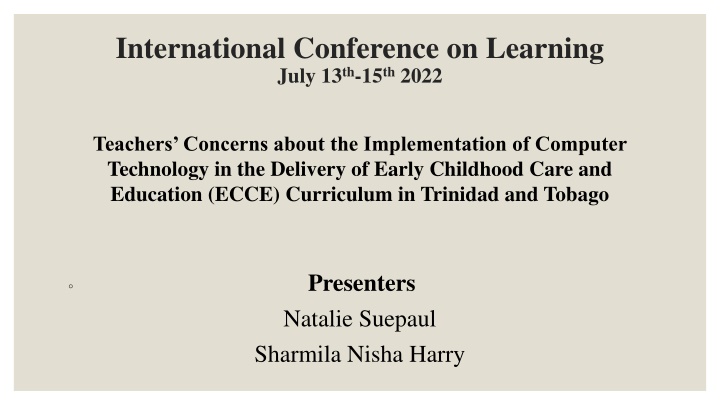
Implementing Computer Technology in Early Childhood Education
Explore the benefits and challenges of integrating computer technology into the Early Childhood Care and Education (ECCE) curriculum in Trinidad and Tobago. Learn about the importance of developmentally appropriate practices and the support from organizations like the National Association for the Education of Young Children (NAEYC) in enhancing children's cognitive and social abilities through technology. Discover how countries like Jamaica and Antigua and Barbuda are leveraging technology to empower young learners and develop essential 21st-century skills.
Download Presentation

Please find below an Image/Link to download the presentation.
The content on the website is provided AS IS for your information and personal use only. It may not be sold, licensed, or shared on other websites without obtaining consent from the author. If you encounter any issues during the download, it is possible that the publisher has removed the file from their server.
You are allowed to download the files provided on this website for personal or commercial use, subject to the condition that they are used lawfully. All files are the property of their respective owners.
The content on the website is provided AS IS for your information and personal use only. It may not be sold, licensed, or shared on other websites without obtaining consent from the author.
E N D
Presentation Transcript
International Conference on Learning July 13th-15th2022 Teachers Concerns about the Implementation of Computer Technology in the Delivery of Early Childhood Care and Education (ECCE) Curriculum in Trinidad and Tobago Presenters Natalie Suepaul Sharmila Nisha Harry
Introduction and Background Technology integration is critical in educational settings around the world for the advancement of students achievement. In the past, computer integration into classroom settings was geared towards students at higher levels. It has since become a crucial component, along with other technologies, in many Early Childhood (EC) settings in developed countries. More recently, it has been finding its way into EC classrooms in developing countries such as those in the Caribbean.
Introduction and Background The long debated controversy of whether computers should be used by children in EC settings has since been clarified. It has been established that computers are beneficial for young children to engage with, providing that developmentally appropriate practices are adhered to during its integration into curriculum activities (National Association for the Education of the Young Child [NAEYC], 2011).
Introduction and Background The NAEYC in its joint position statement with the Fred Rogers Center (2012) stated: Technology and interactive media are tools that can provide effective learning and development when they are used intentionally by early childhood educators, within the framework of developmentally appropriate practice to support learning goals established for individual children. (p.5) NAEYC posits that the use of computers will provide opportunities for the enhancement of children s cognitive and social abilities; support children s learning and offer adaptive scaffolds to ease the accomplishments of tasks.
Introduction and Background Internationally, research supports the integration of computer technology in EC classrooms for improving students learning and development of 21stcentury skills (Couse and Chen 2010; Ogawa and Izumi-Taylor, 2010; Mohammad & Mohammad, 2012). In the Caribbean, countries like Jamaica and Antigua and Barbuda, the use of technology is seen as pertinent. Jamaica views it in helping children to be intellectually empowered and to enrich the child s self- learning (Ministry of Education, 2008). In Antigua and Barbuda there is the Connect Antigua and Barbuda Initiative launched in December of 2006. Part of this programme focuses heavily on introducing the students (aged 2-5) to ICTs, through the development and implementation of a nationwide early childhood education ICT programme.
In Trinidad and computer technology has been introduced into the secondary and primary schools system for over a decade. The Government of the Republic of Trinidad and Tobago (GORTT) made it a goal to provide these young learners with the materials that will stimulate and enhance their holistic development. The creation of the national early childhood care and education curriculum guide as well as the construction of state of the art early childhood centres are proofs of the commitment. The introduction of computers assumed that teachers would integrate this technology across the curriculum to expand and enrich students learning as they explore aspects of their projects each term (Ministry of Education, 2006, pp. 33 & 35). The National ECCE Curriculum Guide highlighted the use of computer technology as one of the means by which a child can become critical thinkers, problem solvers, researchers and intellectually empowered individuals with the 21st century skills necessary for success in a global village.
Justification for the Study While computers and other ICTs are being incorporated into the early childhood setting to enhance teaching and learning, teachers have faced challenges regarding the use of technology in these settings (Han, 2003; Isman, Willis and Dabaj,2006; Wood, Specht, Willoughby and Mueller, 2008). In the ECCE study conducted in Trinidad and Tobago by Eggers-Pierola et al. (2008) it was revealed that the quality indicator Teachers use technology (computer, video, television) appropriately to foster active learning (p. 77) was not observed across the centres. According to Eggers-Pierola et al. it would appear that there is little technology integration into classroom practice (p.78). The use of computer integration in the delivery of the ECCE Curriculum is fairly new to ECCE teachers and therefore it is necessary to understand their feelings regarding this innovation in order for it to be successfully implemented. The study being conducted is at a centre that is three years old and the teachers have only been experiencing this new curriculum for three years, thus it seems necessary to investigate their concerns regarding the integration of computer technology so as to help them to become more efficient and effective in using the technology.
Justification for the Study A number of the research globally highlights the benefits of computer integration; however, there is a paucity of research specifically related to teachers concerns regarding this innovation, particularly in the early childhood context in Trinidad and Tobago. Moreover, teachers are the implementers of educational innovations; hence it becomes necessary to understand their concerns. Cuban (2001) posits that integration of technology into instruction depends a great deal on key factors, such as the contexts in which teachers interact, their beliefs, and their attitudes toward teaching and learning.
Purpose of the Study The purpose of this qualitative case study is to examine the stages of concerns of three teachers at two ECCE centres within one ECCE cluster in relation to the implementation of computer technology in the delivery of the National Early Childhood Care and Education Curriculum. This study will also seek to explore teachers perspectives of the factors that are barriers and facilitators in their implementation of computer technology.
Significance of the Study The researchers are hopeful that the teachers voices would provide information about their concerns and factors contributing to their concerns which would prove to be helpful to the school's administrator in employing strategies to address the concerns of the teachers. It will add to the paucity of local literature on teachers concerns about the implementation of computer integration in the National Early Childhood Care and Education Curriculum The results of the study can be used to inform policy decisions regarding the use of technology in early childhood settings.
Research Questions 1. What are teachers stages of concerns about the implementation of computer technology in the National Early Childhood Care and Education Curriculum at their school? 2. What are teachers perspectives of the challenges that influence their concerns in the implementation of computer technology in the curriculum at their school? 3. How do teachers describe the factors that facilitate their implementation of computer technology in the curriculum at their school?
Theoretical Model-The Concerns Based Adoption Model (CBAM)- (Hall and Hord, 2017) The study uses the theoretical framework of the Concerns Based Adoption Model (CBAM), with specific focus on the Stages of Concern (SoC) dimension. CBAM is a conceptual model/framework that - describes, -explains -predicts teacher concerns and behaviours throughout the change process. Lens to understand the change process. Provides tools and techniques for facilitating and assessing reform/ innovations in education settings
Theoretical framework The Concerns Based Adoption Model (CBAM) CBAM posits that: change is not a one-time event, and teachers are the key to educational improvement their willingness to adopt innovations will determine whether those innovations succeed or fail. Change is accomplished by individuals, and it is a highly personal experience. It involves developmental growth in feelings and skills, and it can be facilitated by interventions directed toward the individuals, innovations, and contexts involved.
Theoretical Model-The Concerns Based Adoption Model (CBAM)- (Hall and Hord, 2017) The Stages of Concern (SoC) dimension deals with the affective side of change. It focuses on how feelings and perceptions evolve as the change process unfolds. SoC describes how people feel about doing something new and their concerns about an innovation as computer integration in early childhood settings at various point in its implementation. One dimension for conceptualizing change in individuals SoC is important because how teachers feel about and perceive a change will in large part determine whether or not change actually occurs in the classroom.
Stages of Concern (SoC) Concerns move through four development levels: - --unrelated --self --task --impact Which encompasses seven distinct, but not mutually exclusive Stages of Concern (SoC)
THEORETICAL FRAMEWORK Source: Stages of Concerns about the Innovation: Paragraph Definitions Note: Implementing Change: Patterns, Principles, and Potholes by Gene E. Hall and Shirley M. Hord, 2006. 6th edition. Boston: Pearson Education. (p. 140)
THEORETICAL FRAMEWORK (Hall & Hord, 2006)
METHODOLGY Qualitative Participants subjective realities Gathering of information that is rich and thick, which is essential to understanding the issue at hand. The collection and analysis of multiple forms of data. qualitative research is an approach for understanding and exploring the meaning individuals or groups ascribe to a social or human problem (Creswell, 2017, p. 4).
METHODOLOGY Case Study: Insights gained from case studies can directly influence policy, practice and future research Case studies have been proven to be particularly useful when studying educational innovations.. The researcher seeks to explore insight, discovery and interpretation rather than hypothesis testing. (Merriam, 1998, p. 19, 41, 65) in-depth description and analysis of a bounded system (Merriam and Tisdell, 2016 p. 37).
METHODOLOGY Sampling Purposive sampling so as to allow the researcher to derive the most meaningful information from those participants who have the information required (Merriam, 1998). Sample two early childhood educators from the St. George East educational district who have been integrating the computer technology into the delivery of the national early childhood curriculum for the past three years.
METHODOLOGY Data collection: Semi-structured interviews (adapted from SoC questionnaire, Hall & Hord, 2017) In this type of interview the interview is a mix of more and less structured questions (Merriam and Tisdell, 2016, p. 110) Reflective journal- record and examine the researchers subjective impressions during the study as a way to control researcher bias (Lodico et al., 2010, p. 132). Open-ended concerns statements a method proposed by Hall and Hord (2006) to assess concerns.
Open Ended Concerns Statement Respondents are asked to write a description of their concerns which is content analyzed.- Hall and Hord, 2017
Data Analysis Adapted from Miles and Huberman, (1994 p. 10) Transcribing of audio-taped interviews verbatim Reading through all the data interview transcripts, reflective journal and open-ended statements this allows for triangulation of the data Coding the data Generating themes Making meaning of the data Writing descriptive narrative (Creswell, 2017).
DATA REDUCTION Adapted from Saldana, J. 2016 p. 14
FINDINGS semi-structured interviews and Open Ended Concerns Statements (OECS). Research Question 1 What are teachers stages of concerns about the implementation of computer technology in the National Early Childhood Care and Education Curriculum at their school? Themes Self Concerns -Informational and Personal Concerns. Task Concerns-lack of resources, lack of Technical Support, Pupil to Computer Ratio, Planning Constraints, Time Constraints and Inadequate Training Teachers experienced a conglomeration of concerns with intense task concerns which continues to be predominant even after three years.
FINDINGS Research Question 2 What are teachers perspectives of the challenges that influence their concerns in the implementation of computer technology in the curriculum at their school? Lack of resources Time constraints Lack of professional development training Research Question 3 3. How do teachers describe the factors that facilitate their implementation of computer technology in the curriculum at their school? Teacher attitude Administrative support Collegial support
IMPLICATIONS Teacher training institutions need to ensure that there are programmes to assist ECCE teachers in developing technological pedagogical skills. The MOE needs to re-visit the goals outlined in the National ECCE Curriculum. More groundwork needs to be done by the ECCE Curriculum Field Officers. ECCE administrators and teachers need to be engaged in continuous learning.
RECOMMENDATIONS The MOE needs to proved funding for adequate resources. The MOE to engage teachers in training for computer integration. Provision of Resources Teacher Training Effective Planning at the Centres Resource Personnel Skilled teachers should assist in training other teachers. An IT technician should be assigned to the centres. Computers need to be more strategically placed in the centres.
References Couse, L. J., & Chen, D. W. (2010). A tablet computer for young children? Exploring its viability for early childhood education. Journal of Research on Technology in Education, 43(1), 75-98. Creswell, J. (2015). 30 essential skills for the qualitative researcher. Los Angeles, CA: SAGE Publications. Creswell. J.W. and Creswell, J.D. (2017) Research Design: Qualitative, Quantitative, and Mixed Methods Approaches. 4th Edition, Sage, Newbury Park Cuban, L. (2001). Oversold and underused: Computers in the classroom. Cambridge, MA: Harvard University Press. Eggers Pierola, C., Skiffington, S. & Helms, B. J. ( 2008). Trinidad and Tobago: Seamless education system project: Early childhood care and education study. Newton: MA: Education Development Centre Inc. Hall, G. E., & Hord, S. M. (2006). Implementing change. Patterns, principles and potholes. (2nd ed). New York: Pearson Education Inc. Hall, G. E., & Hord, S. M. (2017). Implementing change. Patterns, principles and potholes. New York: Pearson Education Inc. Hall, G. E., George, A., & Rutherford, W. L. (1979). Measuring stages of concern about the innovation: A manual for use of the SoC Questionnaire (Report No. 3032). Austin: The University of Texas at Austin, Research and Development Center for Teacher Education. (ERIC Document Reproduction Service No. ED 147 342).
References Hall, G. E. & Hord, S. M. (2016). Implementing change: Patterns, principles, and potholes. Boston: Allyn and Bacon. Han, C. C. W. (2003). Challenges of using ICT in Hong Kong early childhood settings. Young Children and Learning Technologies. Australian Computer Society Inc. Isman, A., Willis, J., & Dabaj, F. (2006). Analyzing pre-school student teachers and their cooperating teachers attitudes towards the use of educational technology. Turkish Online Journal of Educational Technology, 5(4), 1- 88. Lodico, M. G., Spaulding, D. T. & Voegtle, K. H. (2010). Methods in educational research: From theory to practice. (2nd ed.). San Francisco, CA.: Josey-Bass. Merriam, S. B. (1998). Case study research in education: A qualitative approach. San Francisco: Jossey-Bass. Merriam, S.B. & Tisdell, J.E. (2016) Qualitative research: a guide to design and implementation. Josey Bass: San Francisco, CA.
References Ministry of Education (2008). The Jamaica early childhood curriculum for birth to five years: A conceptual framework. Jamaica: Dudley Grant Memorial Trust. Ministry of Education (2006). National early childhood care and education curriculum guide: Nurturing three and four year old children towards the ideal. Trinidad and Tobago. Miles, M. B., & Huberman, A. M. (1994). Qualitative Data Analysis: An Expanded Sourcebook. Thousand Oaks, CA: Sage Publications Mohammad, M., & Mohammad, H. (2012). Computer integration into the early childhood classroom. Education, 133(1), 97-116. NAEYC (2011). Joint position statement of the National Association for the Education of the Young Child and the Fred Rogers Center for early learning: Technology in early childhood programs serving children from birth through age 8. Washington DC: NAEYC. Ogawa, T., & Izumi-Taylor, S. (2010). Tech-knowledge in Japanese early childhood education. Retrieved from www.igi- global.com/chapter/tech-knowledge-japanese-early-childhood/36622 Saldana, J. (2016). The Coding Manual for Qualitative Researchers. Sage Publications Thousand Oaks: CA. Wood, E., Specht, J., & Wiloughby, T. (2002). What early childhood educators need to know about computers in order to enhance the learning environment. Canadian Journal of Learning Technology, 28(1).

